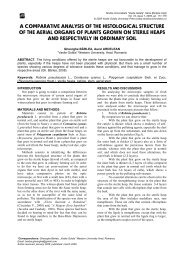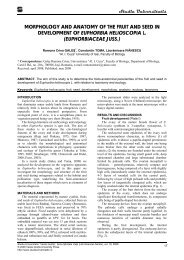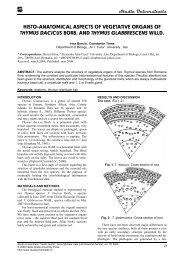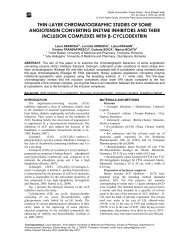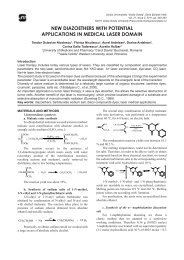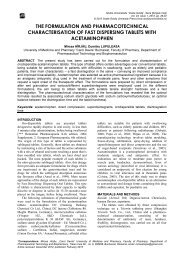flow cytrometric analysis of red blood cells in polycythemia vera
flow cytrometric analysis of red blood cells in polycythemia vera
flow cytrometric analysis of red blood cells in polycythemia vera
Create successful ePaper yourself
Turn your PDF publications into a flip-book with our unique Google optimized e-Paper software.
Flow <strong>cytrometric</strong> <strong>analysis</strong> <strong>of</strong> <strong>red</strong><br />
<strong>blood</strong> <strong>cells</strong> <strong>in</strong> Polycythemia <strong>vera</strong><br />
by the critical po<strong>in</strong>t method and sputter-coat<strong>in</strong>g with<br />
gold, samples were exam<strong>in</strong>ed on a 35 CF JEOL SEM.<br />
RESULTS AND DISCUSSIONS<br />
Light scatter<strong>in</strong>g properties <strong>of</strong> <strong>red</strong> <strong>blood</strong> <strong>cells</strong><br />
<strong>in</strong> Polycythemia <strong>vera</strong><br />
As shown <strong>in</strong> Figures 1 and 2, <strong>flow</strong> cytometric<br />
analyses announce significant morphological changes<br />
<strong>of</strong> <strong>red</strong> <strong>blood</strong> <strong>cells</strong> <strong>in</strong> Polycythemia <strong>vera</strong>. In fact, as<br />
demonstrated <strong>in</strong> Figure 1 and 2, the XGeo Mean values<br />
(cell side scatter) vary from 260 (Patient PV) compa<strong>red</strong><br />
to 299.63 (M), the statistical value for normal RBCs<br />
be<strong>in</strong>g 310 ± 25. In the same way, the YGeo Mean<br />
values (cell density scatter) vary from 196.87 (Patient<br />
PV) to 256.35 (M-To), the statistical value <strong>of</strong> normal<br />
RBCs be<strong>in</strong>g 298± 30. These morphological changes<br />
dim<strong>in</strong>ishes after treatment as shown <strong>in</strong> Figures 2, PVt,<br />
where the YGeo Mean <strong>in</strong>crease to 222.58, value closer<br />
to YGeo Mean <strong>of</strong> normal erythrocytes (M).<br />
Fig. 1. Comparative dot-plot <strong>analysis</strong> FSC/SSC <strong>of</strong> morphological changes <strong>of</strong> <strong>red</strong> <strong>blood</strong> <strong>cells</strong> <strong>in</strong> Polycythemia <strong>vera</strong>. (M):<br />
control erythrocytes; (PV): <strong>red</strong> <strong>blood</strong> <strong>cells</strong> <strong>in</strong> Polycythemia <strong>vera</strong> before and after treatment (PVt); Abscissae: forward<br />
scatter (cell size); ord<strong>in</strong>ates: side scatter (cell density, granularity and refractiveness). Number <strong>of</strong> counted <strong>cells</strong>: 10,000.<br />
Results presented are from one representative experiment <strong>of</strong> three performed<br />
Fig. 2. Comparative histogram <strong>of</strong> X- and YGeoMean values <strong>of</strong> normal (M) and Polycythemia <strong>vera</strong> erythrocytes before<br />
(PV) and after treatment (PVt). Values refer to dot-plot analyses <strong>of</strong> Figure 1<br />
Scann<strong>in</strong>g electron microscopy <strong>analysis</strong><br />
Scann<strong>in</strong>g electron microscopy entirely confirmed<br />
these data and led to the discovery <strong>of</strong> a dysmorphic<br />
RBCs, especially stomatocytes, presented <strong>in</strong> Figure 3a<br />
to 3f, which coexist with discocytes.<br />
Cell viability <strong>of</strong> erythrocytes<br />
We have applied the <strong>flow</strong> cytometric assay we<br />
previously developed for the measurement <strong>of</strong><br />
erythrocyte viability (Bratos<strong>in</strong> et al., 2005). As<br />
described <strong>in</strong> "Materials and methods", the assay is<br />
based on the use <strong>of</strong> Calce<strong>in</strong>-AM, a non-fluorescent<br />
vital dye that passively crosses the cell membrane <strong>of</strong><br />
Studia Universitatis “Vasile Goldiş”, Seria Şti<strong>in</strong>ţele Vieţii<br />
Vol. 21, issue 1, 2011, pp. 29-35<br />
© 2011 Vasile Goldis University Press (www.studiauniversitatis.ro)<br />
viable <strong>cells</strong> and is converted by cytosolic esterases <strong>in</strong>to<br />
green fluorescent calce<strong>in</strong> which is reta<strong>in</strong>ed only by<br />
<strong>cells</strong> with <strong>in</strong>tact membranes. The results we obta<strong>in</strong>ed,<br />
illustrated by the Figure 4, reveal <strong>in</strong> RBCs <strong>of</strong><br />
Polycythemia <strong>vera</strong> patient (PV), an Calce<strong>in</strong> means <strong>of</strong><br />
fluorescence <strong>in</strong>tensity <strong>of</strong> 160, almost double compa<strong>red</strong><br />
to MFI <strong>of</strong> normal RBCs (M). After treatment, MFI<br />
slightly decreases to 156 (PVt).<br />
This <strong>in</strong>creased esterase activity <strong>in</strong> erythrocytes<br />
frompatients with Polycythemia <strong>vera</strong> could be a<br />
possible cause <strong>of</strong> a longer life-time, which would lead<br />
to an <strong>in</strong>crease <strong>in</strong> circulat<strong>in</strong>g hematocrit.<br />
31



